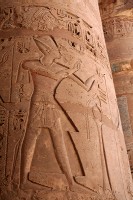Fascinating Facts About Ancient Nubia
History Trivia Nubia is the ancient name of the land directly south of Egypt. This ancient kingdom straddled the Nile River between the first and sixth cataracts where navigation has traditionally been a tricky affair at any time. By land, Nubia was surrounded by deserts. In ancient times Nubia was a literal goldmine for the Egyptians who at times dominated the land and at other periods were rivals of it. The following article shares many fascinating facts about the ancient land and peoples of Nubia as well as several aspects of archaeological significance.
Nubia is the ancient name of the land directly south of Egypt. This ancient kingdom straddled the Nile River between the first and sixth cataracts where navigation has traditionally been a tricky affair at any time. By land, Nubia was surrounded by deserts. In ancient times Nubia was a literal goldmine for the Egyptians who at times dominated the land and at other periods were rivals of it. The following article shares many fascinating facts about the ancient land and peoples of Nubia as well as several aspects of archaeological significance.
Today, area of ancient Nubia is sporadically populated. Lower Nubia lies in Egypt while upper Nubia is owned by Sudan.
At one time, Nubia was comprised of lands that included all of present-day Sudan, Somalia and Ethiopia.
Ancient Egyptians referred to the region to the south as Ta-Seti or land of the bow because of the skilled archers who lived there.
The earliest Nubians are known to have thrived from c.3500 to 3100 BC occupying villages in lower Nubia. These peoples traded exotic East African wares with the Egyptians.
In times of peace throughout the ancient period, Nubians also supplied grains, ivory, ebony and leopard skins with their neighbors to the north.
After 3100 BC, the Nubians of the area were subject to Egyptian control who built forts in lower Nubia to extract slaves, gold and cattle from the culture there. Consequently, the archaeological evidence from this period points to villages that worked more like garrison towns.
From c.2500 to 1500 BC, the Nubians exhibited what is called the “Pan-Grave” culture due to its burial customs that include a literal pan-shaped grave. Such graves have also been discovered in Egypt.
South of the third cataract, the Nubian state at Kerma began to expand. Between 1800 and 1550 BC the warriors of Kerma controlled the old Nubian forts left behind by the Egyptians.
The prince of Kerma allied his state with Hyksos and Canaanite rulers. At this point, Kerma became a populous city filled with artisans and buildings.
By 1550 BC, Kerma fell victim to Egypt’s warrior kings of the eighteenth dynasty who were looking to expand their kingdoms. The area was then controlled by an Egyptian magistrate known as the Viceroy of Kush. For the next four centuries, Egypt would control the Nubians directly.
Setau, Viceroy of Kush, had the Temple of Ptah built in Lower Nubia; he served under Ramses II. Setau also built the larger of two temples built on the west bank of the Nile at El-Sebua.
It was under Egyptian rule that the famous temples of Ramses II were constructed at Abu Simbel and many other important monuments that date to Egypt’s New Kingdom.
By roughly 1070 BC, Egyptians began to withdraw from the area and a Nubian rose near the town of Napata. The subsequent culture was a unique blend of Nubian and Egyptian culture that collided in language and religion.
It was the Napatans who eventually conquered Egypt and ruled it during the twenty-fifth dynasty known as the Kushite period.
By 663 BC, the Nubian pharaohs were pushed out of Egypt by conquering Neo-Assyrians.
Nubians, however, retained the love for pyramid building. There were more royal pyramids built in the Sudan than in all of Egypt.
Subsequent Nubian culture-known as Meroe–developed the first system of writing in Africa-besides the Egyptians. They remained an important culture through the Roman era that traded with them for exotic African goods.
The first European account of Nubia was written by Herodotus in 420 BC. He called it Aethipia-not to be confused with Ethiopia.
Nubian culture continued to flourish for a subsequent thousand years after the fall of the Egyptian civilization.
